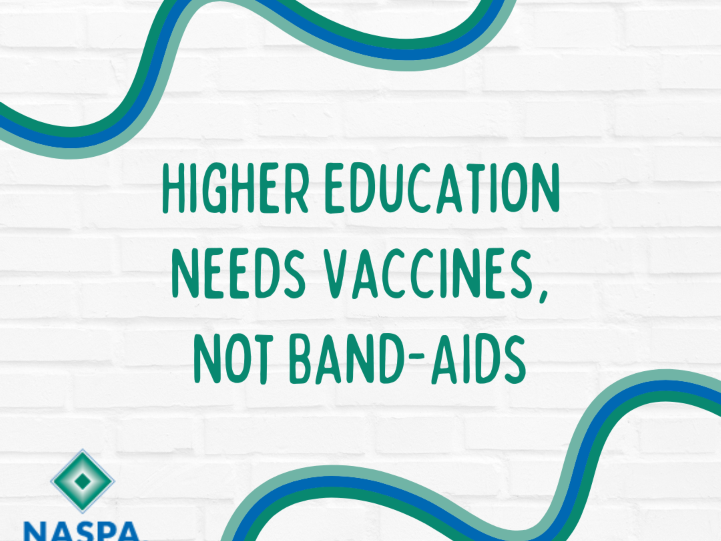
Higher Education Needs Vaccines, Not Band-Aids
Policy and Advocacy New Professionals and Graduate Students
August 2, 2022
For years, student affairs has had to pave a way for itself in the landscape of higher education. Battling budget deficits, staffing and spacial limitations, and the inevitable comparison of the necessity of our work to that of our colleagues in academic affairs, we have learned to adapt, consider, and lead new initiatives that demonstrate our worth as a field. And on that front, I would say we are succeeding. But if we consider our path to equity and social justice, I am less convinced that we are moving forward appropriately.
It is no secret that higher education is deeply affected by the systems of oppression that govern our society. Far too often, institutions that are seen as beacons of progressive social change are the same ones that are put in the spotlight for their failures to address instances of white supremacy, antisemitism, xenophobia, sexism, cissexism, and other forms of marginalization on campus. Despite these failures, colleges and universities have adapted and responded at best, with resolute action steps (with a questionable level of impact) and at worst, with indifference, negligence, and harm.
Some of the best responses that we have seen over the years have included an upsurge in identity centers, vice-presidential positions for diversity and inclusion, scholarship funds, and affirmative action. And yet, for all of the positive changes that we have seen, I would argue that we have yet to see the kinds of changes needed to completely shift the paradigm of experiences for marginalized people on college campuses. BIPOC and LGBTQ students still face acts of violence and microaggressions daily. Disabled students and students with disabilities often still need to be their own advocates for services in the classroom. Undocumented students still face the fear of deportation. Religious minority students still are required to attend classes on their high holy days while the university closes for Easter and Christmas. The same structures that keep the privileged in power and the marginalized oppressed exist today in many of the ways that they did decades ago.
We have grown accustomed to treating the symptoms and not the problems. For example, during the 2020 presidential election, many college students were feeling heightened levels of anxiety and depression due to a global pandemic, election fraud, and a notable white supremacist clawing his way to stay in power. Knowing this, student affairs practitioners across the country created virtual spaces for students to come together, share their frustrations, and be in community with one another. We created panel events that discussed the impact of racism in our community. We attended debate watch parties. We held community conversations on “the unprecedented times,” “self-care and community care,” “mindfulness workshops,” and “navigating difficult conversations.” All of these programs, while certainly well-intentioned and hopefully impactful for the students that attended, only address the anxiety that students were facing as opposed to addressing the circumstances that created the anxiety in the first place.
Even the “actionable items” that colleges work towards often fail at creating change at the systemic level. For example, after the murders of George Floyd, Breonna Taylor, Ahmaud Arbery, Tony McDade, and Dion Johnson, students, faculty, and staff mobilized at great lengths to demand a response and change from their colleges and universities. And what were they met with? Committees. Task forces. Reading groups. Town halls. Vigils. Each of these responses is important and necessary to starting/continuing conversations around social change but often do not lead to liberation in and of themselves.
So what does liberatory work look like? For starters, I think that it could look like long-term programming around sustainable advocacy. For example, instead of only offering space for students to process election uncertainty, we could offer a semester-long leadership series around developing activist/advocate mindsets. As another example, instead of only rewording the nondiscrimination statement to include more marginalized groups of people, we can also think through what real disciplinary procedure can look like for individuals who violate the nondiscrimination statement. We give far too much leniency to individuals who knowingly harm others with their refusal to abide by the nondiscrimination statement.
Finally, I would argue that real liberatory work must start with financial compensation and resources. It is not enough to hire a Vice President for Diversity & Inclusion or one staff member for a cultural center and pay the absolute bare minimum (and sometimes not even that). We should prioritize funding for full staffing of identity- and equity-focused spaces, including paid opportunities for graduate and undergraduate staff. Without funding, individuals who are deeply devoted to creating more inclusive and equitable spaces will not be able to make significant headway in changing the campus climate or the culture of higher education more broadly. As has been said by many others, when it comes to DEI work, we need to put our money where our words are.
I am not going to pretend like I have all the answers nor am I going to pretend that it will be easy work. What I do know is that we have invested too much of our energy into the Band-Aids and not enough energy into the vaccines. A one-off program is not a vaccine. A committee is not a vaccine. The reason I know it is not a vaccine is because a vaccine would have prevented further instances of oppression, marginalization, and inequity. We will only know that we have created a vaccine when we no longer need the Band-Aids.
Author: Steven Feldman (he/they) is a PhD Higher Education student at Indiana University Bloomington and previously served as the Associate Director of the Center for Trans & Queer Advocacy at West Chester University. In their free time, they enjoy playing Pokémon Go and drinking iced coffees from Dunkin’. Steven can be found on LinkedIn and Twitter at @sfeldman990.